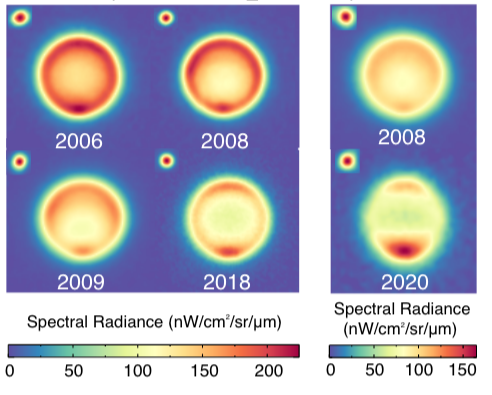Variation in Neptune's Mid-Infrared Emission from Ground Based Imaging
- 1School of Physics and Astronomy, University of Leicester, Leicester, UK
- 2Jet Propulsion Laboratory, California Institute of Technology, Pasadena, CA 91109, USA
- 3Space Science Institute, Boulder, CO 80301 USA
- 4Southwest Research Institute, San Antonio, TX 78238-5166, US
- 5UPV/EHU, Escuela Ingernieria de Bilbao, Fisica Aplicada, Spain
- 6Department of Physics, University of Oxford, Parks Rd, Oxford OX1 3PU, UK
- 7Subaru Telescope, National Astronomical Observatory of Japan, Hilo, Hawaii, USA
We present results from a comprehensive analysis of mid-infrared imaging of Neptune's atmosphere. Using all currently available ground-based images, we show how Neptune's mid-infrared emission has changed over the past decades in images sensitive to stratospheric ethane, methane, and temperatures. Neptune's stratospheric thermal emission appears to vary significantly on sub-seasonal timescales of years or less with significant latitudinal asymmetry not predicted by seasonal radiative and photochemical models. In particular, Neptune's stratospheric temperatures have declined globally since 2003, although northern and southern latitudes varied separately. In just the past few years, Neptune's south polar region has dramatically brightened while the remainder of the stratosphere has grown colder. These collective observations provide the strongest evidence to date that processes produce significant variability in Neptune's stratosphere on sub-seasonal timescales.
Background: Despite being the most distant giant planet from the Sun, the ice giant Neptune possesses an extremely dynamic atmosphere, with meteorological phenomena evolving over a surprising range of timescales. Theory predicts Neptune's 165-year orbital period should modulate Neptune's stratospheric temperatures and chemistry [1] and, potentially, upper tropospheric temperatures [2] very slowly across seasons lasting several decades. But a growing body of mid-IR observations over the past decades are starting to reveal that Neptune's stratosphere is likely even more dynamic and variable than previously known [3].
Analysis: Ground-based imaging of Neptune at mid-infrared wavelengths (~7.7--24.5 µm) dating back to 2003 are collected, calibrated, and analysed to reveal trends in time.
Results: Significant changes in radiance are detected over the past two decades, with some occurring over periods of just a few years. For example, images sensing stratospheric ethane show a significant drop in radiance between 2006 and 2009, particularly at southern mid-latitudes (see Figure 1). By 2018, similar images show emission further reduced. However, between 2018 and 2020, the southern pole grew dramatically brighter. Our analysis indicates these observed changes are primarily due to changes in the stratospheric temperatures and, likely, the ethane mixing ratios. These results further suggest the importance of modulating solar UV flux and/or sub-seasonal dynamical processes in Neptune's stratosphere.

Figure 1. Images of Neptune acquired in different years in filters sensitive to emission from stratospheric ethane. (Left) Images acquired with the VLT-VISIR 12.2 µm filter show a that the observed radiances drop over time, beginning at southern mid-latitudes (Right) Images from Subaru-COMICS 12.4 µm filter show a dramatic increase in the south polar radiance between late 2008 and mid-2020. Together, these data suggest a rapid brightening of the Neptune's south polar vortex between mid-2018 and mid-2020.
References:
[1] Moses et al., 2018, Icarus 307: 124-145
[2] Li et al., 2018, JQSRT, 217, 1105 353
[3] Hammel et al., 2006, ApJ, 664, 1326-1333
How to cite: Roman, M. T., Fletcher, L. N., Orton, G. S., Rowe-Gurney, N., Moses, J., Greathouse, T., Sinclair, J., Antunano, A., Irwin, P. G., Kasaba, Y., Fuhiyoshi, T., and Blake, J.: Variation in Neptune's Mid-Infrared Emission from Ground Based Imaging, Europlanet Science Congress 2021, online, 13–24 Sep 2021, EPSC2021-215, https://doi.org/10.5194/epsc2021-215, 2021.

